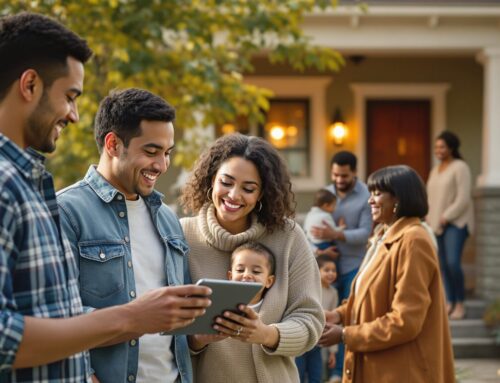Saving for a home is tough, but 2025 brings new solutions. Down Payment Assistance (DPA) programs now offer an average of $18,000 to help buyers overcome affordability challenges like high interest rates and rising home prices. With over 2,500 programs available – a 55% increase from last year – these initiatives are more accessible and flexible than ever. Key updates include:
- Expanded eligibility: 10% of programs have no income limits, and 38% are open to repeat buyers.
- More forgiveness: 53% of programs forgive partial or full loans if conditions are met.
- Support for diverse buyers: Special programs for first-generation buyers, educators, first responders, and manufactured-home owners.
- Streamlined applications: Tools like Freddie Mac‘s DPA One® simplify finding and applying for assistance.
Whether you’re a first-time buyer or looking for specialized support, DPA programs in 2025 offer practical ways to make homeownership a reality.
Major Changes in Down Payment Programs
Updated Qualification Rules
In early 2025, down payment assistance (DPA) programs introduced income-neutral options and expanded first-generation initiatives, making homeownership more accessible for a broader range of buyers. Specifically, there were 19 first-generation homebuyer programs in Q1 2025 – a 16% increase – designed for buyers whose parents never owned homes.
The manufactured housing market also experienced growth. The number of programs available for manufactured homes increased from 914 in Q4 2024 to 971 in Q1 2025[1]. This shift highlights growing acceptance of manufactured homes as a practical route to homeownership.
New Laws and Regulations
Many programs now extend beyond down payments to cover closing costs, rate buydowns, and other expenses. Notably, 80% of these programs defer repayment, and 53% offer partial or full forgiveness if residency requirements are met[1].
Digital Application Systems
To complement these changes, application processes have become more streamlined. In September 2023, Freddie Mac introduced DPA One®, a free tool designed to simplify program searches and matching. It’s already being used by over 4,400 loan originators to help clients access assistance[2].
"More programs now include manufactured and multi-family homes, opening new paths to affordability and steady income. For lenders, that means more ways to qualify buyers and close loans in a tough market." – Rob Chrane, founder and CEO of DPR[1]
These updates in technology and regulations are reshaping who can qualify and how funds can be used. Next, we’ll dive into the specifics of eligibility criteria.
Best Down Payment Assistance Programs in 2025
Who Can Apply in 2025
Here’s a breakdown of who qualifies for the 2025 DPA programs.
Basic Requirements
Eligibility rules have expanded for 2025, making these programs more accessible. Most require a credit score of at least 580, the home to be your primary residence, and completion of a homebuyer education course. Income limits are typically tied to the area median income (AMI), but 240 programs (10%) have removed income limits altogether [1].
Programs by Buyer Type
There are 19 programs specifically for first-generation buyers, marking a 16% increase. Additional programs target specific groups, including educators (69 programs), protectors (56 programs), veterans (50 programs), Native Americans (50 programs), and surviving military spouses (20 programs, an 18% increase) [1].
Program Comparison Chart
Here’s a quick comparison of key program features:
| Program Type | Income Requirements | Average Benefit | Repayment Terms |
|---|---|---|---|
| Standard DPA | Based on AMI (varies) | $18,000 [1] | 80% offer deferred payment [1] |
| First-Generation Homebuyers | Varies | Varies | Forgiveness options available |
| Professional (Educators/Protectors) | Varies | Varies | 53% offer partial/full forgiveness [1] |
| Manufactured Home DPA | Varies | Varies | Offered through 971 programs [1] |
Money Sources and Program Types
Let’s break down the funding sources behind 2025 down payment assistance (DPA) programs and the organizations providing them.
Types of Financial Help
In 2025, DPA comes in several forms:
- Grants: Funds that don’t need to be repaid.
- Forgivable loans: Second liens forgiven after 36 months of on-time payments.
- Deferred-payment loans: Repayment is delayed until the home is sold, refinanced, or no longer the primary residence.
Some examples include the Golden State Finance Authority, offering grants up to $350,000 [3]; the Chenoa Fund, which provides forgivable liens between 3.5% and 5% [4]; and Denver metroDPA Social Equity, which grants $15,000–$25,000 [5].
Government and Private Programs
Both government agencies and private organizations offer DPA programs, often designed to meet local needs [4]. The District of Columbia Housing Finance Agency outlines one such program:
"A no-interest, non-amortizing loan due upon sale, transfer, refinance, or ceasing to occupy the home as a primary residence within five years. It’s available to low- and moderate-income borrowers, both residents and non-residents of DC." [5]
These varied funding sources and providers are shaping the growing landscape of down payment assistance.
sbb-itb-8115fc4
Program Benefits and Access Tools
DPA programs in 2025 go beyond just funding – they now combine improved financial benefits with easier-to-use digital tools.
Financial Support Options
DPA programs in 2025 provide expanded financial assistance and better digital accessibility. For instance, New York City’s HomeFirst program offers up to $100,000 to help with down payments or closing costs [9]. Assistance options include covering down payments, closing costs, reducing interest rates, and rate buydowns. Many programs also defer repayment or forgive loans entirely if homeowners maintain the property as their primary residence [1].
Digital Tools for Easier Applications
To make these benefits more accessible, digital platforms simplify the process of finding and applying for assistance. Here are three standout tools in 2025:
- DPA One by Freddie Mac: A free tool for housing professionals to locate and understand down payment assistance programs across all 50 states and DC [6].
- Down Payment Resource: Connects homebuyers and housing professionals with more than 2,000 homeownership programs, including those for down payment and closing cost assistance [7].
- Fannie Mae’s Down Payment Assistance Search: Developed with DownPaymentResource.com, this tool lets users compare up to four programs side-by-side [8].
"DPA One is so convenient. I can go to one place and have all the information I need. It’s a time saver." – Elliot Santiago, Manager at Prosperity Home Mortgage [6]
Overview of Top Programs
| Program Type | Maximum Assistance | Forgiveness Terms |
|---|---|---|
| HomeFirst NYC | $100,000 | 10–15 year residency required |
| State HFA Programs | Varies by state | Terms depend on the state |
| National Homebuyers Fund | Based on need | No repayment required |
| VA/USDA Programs | Up to 100% | Not forgivable; requirements apply |
Note: Most programs require first-time buyer status or income qualifications.
These updates highlight the shift toward more flexible and borrower-friendly options in 2025.
"Rates are still high and prices keep climbing, but we’re seeing expanded program offerings, new providers and greater flexibility in how funds are used – not just for down payments but also to cover closing costs, lower the rate or meet other buyer needs." [1]
How to Use DPA Programs
Ready to apply for down payment assistance? Here’s how to get started.
Coordinating DPA with Your Mortgage
Down payment assistance programs in 2025 provide flexible options for covering various costs. Talk to your lender about how DPA funds can work with your mortgage – whether you need help lowering your loan-to-value ratio, covering closing costs, or buying down your interest rate.
What You’ll Need
To apply, gather the necessary documents, which may include:
- W-2s or 1099s
- Recent pay stubs and bank statements
- Proof of area median income
- A homebuyer education certificate
Get a Head Start
- Research available programs using Down Payment Resource [7].
- Check eligibility rules, repayment terms, and property requirements [1].
- Pre-qualify online to estimate your assistance amount and focus your home search.
Conclusion: What’s Next for DPA Programs
By 2025, Down Payment Assistance (DPA) programs are offering more funding options and benefits for borrowers. On average, these programs now provide $18,000 in assistance, with 80% featuring deferred repayment and 53% including partial or full loan forgiveness over time [1].
Here’s what’s changing:
- More property choices: Manufactured housing programs increased by 6%, reaching 971, while multifamily assistance programs grew by 3% [1].
- Focused support: Initiatives for first-generation homebuyers rose by 16%, and programs for surviving military spouses grew by 18% [1].
- Specialized incentives: Assistance tied to below-market-rate or resale-restricted properties jumped by 18%, and energy-efficiency incentives increased by 17% [1].
These developments highlight how DPA programs continue to play a critical role in helping a wide range of homebuyers achieve their goals in 2025 and beyond.
FAQs
What are the key requirements to qualify for loan forgiveness in down payment assistance programs?
To qualify for loan forgiveness in down payment assistance programs, you typically need to meet specific conditions that vary by program. Common requirements include making a certain number of consecutive, on-time payments on your primary mortgage or living in the home as your primary residence for a set period.
For example, some programs forgive the loan after 36 months of consistent mortgage payments, while others may require you to remain in the home for five years or more. If these conditions aren’t met, you may need to repay the assistance, sometimes with interest.
Always review the terms of your program carefully to understand the eligibility criteria and ensure you meet the requirements for forgiveness.
What’s the best way to find a down payment assistance program that suits my needs?
Finding the right down payment assistance program starts with understanding your financial situation and homeownership goals. Many federal, state, and local housing agencies offer programs tailored to first-time buyers, low-to-moderate income families, and underserved communities. Non-profit organizations and certain lenders also provide assistance options.
To get started, research programs in your area by contacting your state’s housing finance agency or local government offices. You may need to meet specific requirements, such as completing a homebuyer education course or meeting income limits. Additionally, consider reaching out to a housing counselor for personalized guidance. These steps can help you identify the best resources to make homeownership more accessible and affordable.
Are there extra costs or fees when applying for down payment assistance programs?
While down payment assistance (DPA) programs can be a great resource, some may come with additional costs. These could include application fees, origination fees, or slightly higher interest rates compared to traditional loans. These expenses can affect the overall cost of your loan, so it’s important to carefully review the terms of any DPA program you’re considering.
Make sure to ask your lender or program administrator about any potential fees upfront to avoid surprises and ensure the program aligns with your financial goals.
Related posts







